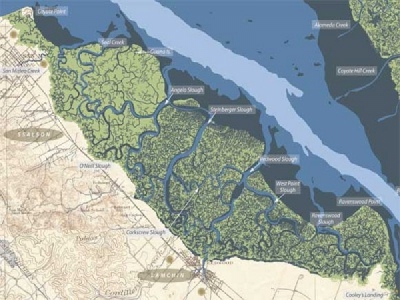
Posted on June 27, 2017
By Anna Schuessler, Daily Journal
In an effort to curb flooding around Belmont Creek, a multi-jurisdictional group of agencies is teaming up to devise ways to redirect the flow of the waterway running through Belmont and parts of San Carlos and unincorporated San Mateo County.
Though widening an underground pipe along Harbor Boulevard and restoring the creek bed on the portion of Belmont Creek that runs through Twin Pines Park are among the strategies public officials are considering to reduce flooding emanating from the creek, the group is taking a closer look at longer term solutions expected to mitigate creek overflows and restore the natural habitat the creek offers.
Belmont Public Works Director Afshin Oskoui said the group, which includes Belmont, San Mateo County and San Carlos along with Redwood City and Caltrans, have become aligned on finding ways to work on the creek’s flow after years of flooding in the area largely bordered by El Camino Real, Highway 101, Harbor Boulevard and San Carlos’ northern border plagued businesses with warehouses and offices there.
“To really solve the problem, it takes more of a partnership of all the agencies involved,” he said.
Originating at Water Dog Lake, the creek runs through Belmont’s downtown underneath Sixth Avenue and El Camino Real and jogs south around the Caltrain tracks to flow parallel to Harbor Boulevard before it empties into a slough in Redwood Shores. Oskoui said that due to the flatness of the area where the creek crosses the Caltrain tracks near Old County Road, sediment has collected there and created the conditions for flooding during heavy storms.
Oskoui said that dredging the portion of the creek that runs between El Camino Real and Old County Road five times in the last seven years has helped reduce some of the flooding. But when Novartis Pharmaceuticals — whose San Carlos offices at 150 Industrial Road experienced flooding — stepped in to initiate one of the dredging projects in 2014, he said, the company also spearheaded a study of longer term solutions.
The study would not only give public officials a clearer picture of how the creek and the land surrounding it could be improved to prevent flooding, it also brought the group of agencies in the creek’s path together in searching for new strategies, he said.
“They stepped up to the plate,” said Oskoui, and added that the agencies are now looking to validate strategies identified in the 2014 study and identify a path toward minimal flooding in the area.
Though adjustments to the design of Water Dog Lake and additional tidal gates at Marine Parkway were among the solutions identified in the study, Oskoui said two strategies were selected by the group of agencies for further review. Widening a by-pass culvert, or underground pipe, along Harbor Boulevard to better handle the creek’s flow during heavy storms and adding vegetation to stabilize the creek bed along the portion of the creek that runs through Twin Pines Park would both reduce flooding around the creek and enhance its natural elements, two goals Oskoui said the group is prioritizing.
When the Belmont City Council discussed a second study focusing on these strategies earlier this month, Councilwoman Davina Hurt said she hoped it could also inform the Parks and Recreation Department’s efforts to form a master plan for Twin Pines Park. She expressed enthusiasm for the working group’s dual focus on fortifying the creek’s ability to withstand a high volume of water and improving the water quality and natural habitat.
“I hope that in looking at this in the future, that we keep those dual approaches,” she said.
Belmont resident Perry Kennan expressed disappointment that many creeks and rivers in California are hidden underground instead of being incorporated into urban landscapes. He implored city officials to inform Belmont residents about what strategies are being considered so they could weigh in throughout the process.
“Is it going to end up where we’re hiding more of the few signs of Belmont Creek that we have right now?” he asked.
Oskoui said a series of workshops with community members and stakeholders is included in the next study, which he expects to take another 18 to 24 months. He said the study would also include an analysis of how the improvements identified could be funded. Widening the culvert and restoring the creek bed at Twin Pines Park could cost up to $24 million, he said. Though Belmont has dedicated $100,000 to fund part of the upcoming study, Oskoui expects grant opportunities to be a key source of the funds needed.
Source: Daily Journal





